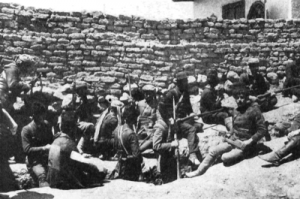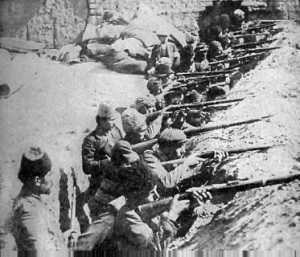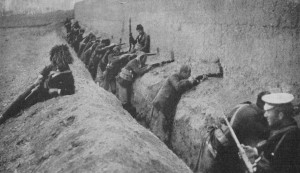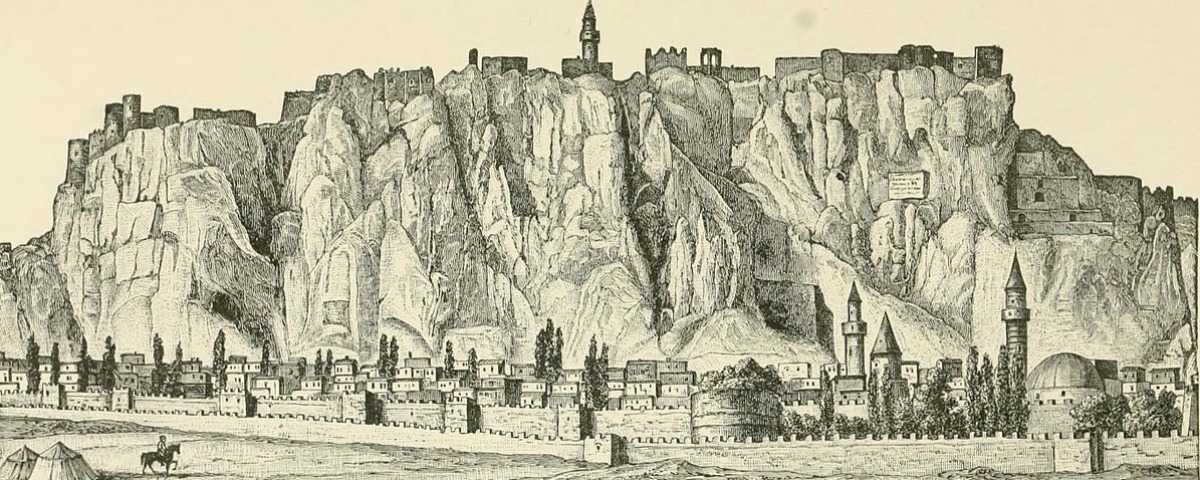In the spring of 1915, while the world watched events in the Dardanelles, one small Armenian community in a distant corner of the Ottoman Empire waged a desperate battle of national survival.
Turks and Armenians
During the late 19th century, relations between Turks and Armenians in the Ottoman Empire steadily worsened to the point of irreparability. At a time when the “Sick Man of Europe” was being brought to the point of death by Christian nationalist movements in the Balkans, Christian Armenian calls for greater autonomy within the Empire were met with hostility by Ottoman authorities. Because the Armenian territories of the Near East straddled both the Ottoman and Russian Empires, they were increasingly suspected by the Sublime Porte of being a dangerous fifth column in league with their ethnic and religious brethren across the border.
In 1896, the “Red Sultan” Abdul Hamid II instigated a series of Empire-wide massacres that killed over 300,000 Armenians and displaced many more. Although Abdul was forced to abdicate in 1909, counterrevolutionary riots in the city of Adana saw another 30,000 Armenians wantonly murdered. While at first it seemed that the reformist Young Turks movement that forced Abdul’s abdication would spell a new era of ethnic and religious cooperation, in 1913 the ultranationalist and authoritarian Committee of Union and Progress (CUP) seized power and established a triumvirate of de facto dictators. The new powers that be made no secret of their Pan-Turanian vision of uniting all the Muslim Turkic peoples of Central Asia in a single Islamic state. By 1914, the government’s militant nationalism, growing international involvement in the Armenian Question, and the resettlement in Armenian areas of hundreds of thousands of Muslim refugees from the Balkans, combined to create a powder keg of tension between Ottoman Turks and Armenians. The Ottoman Empire’s entrance into the First World War proved the spark.
Scapegoats for Disaster
In the winter of 1914, Enver Pasha, the Empire’s leading triumvir, ignored the advice of his military experts and invaded the Russian Caucasus in the dead of winter in the hopes of sparking a revolt among the region’s Turkic Muslim inhabitants. In the snow-choked mountain passes, his poorly equipped men died by the thousands of cold, hunger and disease before even coming to grips with the enemy. Beginning on New Year’s Day 1915, Enver’s offensive was decisively defeated by Czarist forces during the four-day Battle of Sarikamish. Of the 95,000 men of the Ottoman Third Army that began the campaign, barely 18,000 bedraggled survivors made it back to Turkey where they were forbidden from speaking of the horrors they experienced. It was a crushing and humiliating defeat that severely hindered the Ottoman war effort for the rest of the conflict. Desperate for a scapegoat, Enver blamed local Armenians and Armenian deserters for aiding the enemy and precipitating the calamity.
The area in which the Sarikamish campaign was fought encompassed the heartland of historic Armenia. To rouse the support of disaffected locals, the Russians employed their own Armenian units on the front lines, and on December 30, 1914, while on a visit to the front, Tsar Nicholas II told the head of the Armenian Church that “a brilliant future awaits the Armenians.” To be clear, many Ottoman-Armenian troops and civilians did take advantage of the deteriorating situation to switch sides and no doubt aid the enemy in exacting revenge on their erstwhile persecutors. However, many Ottoman-Armenians also stayed loyal to their Sultan and fought hard to prove their loyalty. In fact, Enver initially praised the performance of his Armenian troops. He even wrote a letter to the Armenian Patriarch of Konya in which he lauded their bravery and singled out an Armenian Sergeant-Major named Hovhannes for single-handedly saving him from capture.
Though it was absurd to blame the Armenians alone for a disastrous campaign, poorly led and fought in blizzard conditions oftentimes at elevations of 6,500 feet, in the tense wartime atmosphere such CUP propagations were easily spread and readily believed by a confused and fearful public. When American Ambassador Henry Morgenthau inquired into events in the east, he was blatantly told by Taalat Pasha, Enver’s co-dictator who surely knew the truth of what had occurred, that the Armenians had “assisted the Russians in the Caucasus and our failure there is largely explained by their actions.” The response of the CUP was swift and devastating and set in motion the machinations for genocide.
Beginning in February 1915, all Armenian men in the Ottoman army were disarmed and pressed into labour battalions where they were worked to death or simply executed in groups. Armenian citizens that had been allowed to carry arms following the Young Turk Revolution were required to turn in their weapons and similarly carted off to perform menial work at the front. In Armenian areas, particularly those along the front lines, the local populace was subjected to a ruthless campaign of arbitrary raids, arrests and murders, ostensibly to root out hidden weapons and deserters. Among the areas particularly targeted by the Ottoman authorities was the predominantly Armenian vilayet (province) of Van.
Heaven to Hell
Van was situated high in the mountains of southeastern Anatolia at the crossroads of the Ottoman, Russian and Persian frontiers. It was centered on Lake Van, a large, sapphire-blue body of water whose bright colour and mirror-like calm contrast sharply with the surrounding snow-capped mountains. The lake creates a fertile plain with a gentle microclimate that, at the turn of the 20th century, was home to over 100 villages and innumerable orchards, vineyards and exotic flower gardens. The region was once the heart of the medieval Armenian kingdom of Vaspurakan, a legacy that still showed in the many historic churches and monasteries that dotted the mountainsides. The most famous, the Cathedral of the Holy Cross, dates back to the 9th century and to this day sits on one of the lake’s four islands. The locals’ love for the rugged beauty of the region is illustrated in an old Armenian proverb: “Van in this life, and heaven in the next.”
The capital of the province was the city of Van, which was composed of two segments: an old and a new. Old Van was an ancient walled settlement built into the base of a 300-foot rock, atop of which sat an old Ottoman citadel. The city below was a maze of narrow streets crowded with churches, mosques, shops, bazaars and multistory brick and cob houses. Roughly six miles to the east, linked by a causeway, was the modern new city, which was known as “The Gardens” because of its many poplar and willow plantations. A fire in 1876, followed by a series of epidemics, had spurred many citizens to leave the overcrowded old city in favour of a wider and cleaner space, and by 1915, eighty per cent of Van’s 41,000 people lived in the gardens.
More than half of the population were Christian Armenians, while the rest were a mix of Muslim Turks, Kurds and Circassians. In both old and new Van, Armenians and Muslims lived in separate quarters with Armenians in the east and Muslims in the west. During the late 19th century, Van had become an important Armenian cultural centre and developed an active political intelligentsia with links to Armenian parties and organizations throughout the Empire. The area had resisted the Hamidian Massacres, and twenty years later the cityscape was still scarred by numerous burned and pillaged Armenian homes and properties. The Armenian section of the gardens was also home to a number of foreign consulates and Christian missions from Europe and the United States, which catered to the many poor and destitute Armenian families that had lost homes and loved ones during the violence.
For the people of Van province, the first sign of trouble came in mid-February 1915 when their much-loved governor, Tahsin Pasha, was replaced by Enver’s brother-in-law, Jevdet Bey. Tall, handsome and exquisitely well-kempt, Jevdet appeared the epitome of the eastern gentleman. However, beneath the courteous manners and fine-tailored Parisian suits was a cruel, ruthlessly ambitious sadist with a well-known hatred for the Armenians of Van. As a repressive district governor before the war, he had earned the nickname “The Horseshoer of Bashkale” because of his predilection for nailing horseshoes to the feet of his Armenian victims. Nor were his fellow Turks above his wrath. One of his officers, the Venezuelan mercenary Rafael de Nogales, noted the ease with which this “panther in human form” had political opponents and disobedient subordinates murdered.
In late March, Jevdet arrived in the capital where he was greeted by a delegation of Armenian political and spiritual leaders. To everyone’s surprise, he offered kind words and assurances of peace. It was all a ploy. With the Armenians lulled into a false sense of security, the new governor proceeded to unleash a reign of terror in the countryside. He had brought with him a battalion of convicts dubbed the “Butcher Regiment” that set about indiscriminately pillaging Armenian farms, desecrating churches and raping and murdering civilians. Within the course of a few weeks, 51 Armenian villages disappeared from the map of Van forever in a slaughter so wanton that even local Muslims were threatened with death for aiding their Christian neighbours. When a group of Armenian leaders approached him to discuss peace, he had them killed, and even ordered a widely respected Armenian parliamentarian assassinated on the road to Constantinople.
 The Armenians Resist
The Armenians Resist
The throngs of terrified refugees and the murder of their leaders sent shockwaves through the city of Van. For weeks they had also noticed a growing number of Turkish troops entrenching around their quarters and now it seemed confirmed that Jevdet planned to destroy them. If there was one positive effect to the terror, it was that it erased the social and political differences that had long divided the Armenians of Van and united them in the common goal of survival. A “National Self-Defense Committee” composed of local leaders was formed, and during secret night-time meetings, a defensive plan was formulated. The Armenians responded to Jevdet’s tightening grip on the city by walling up their homes, barricading their streets and digging their own trenches. Arms were distributed and mixed Muslim and Armenian neighbourhoods were evacuated. On April 19, the Bishop of Van sent one more peace overture to Jevdet only to be told: “This country will remain the Armenians’ or the Turks’, but it is impossible for both to coexist.” The battle lines were drawn.
The two sides were in many ways pathetically mismatched. Jevdet had at his disposal almost 12,000 men, half of which were Kurdish and Circassian irregulars, well-armed with rifles, grenades and machine guns. He also had a few dozen artillery pieces of various sizes, most of which he placed in the Ottoman citadel high atop the old city. From there he could survey the Armenian quarters as clearly as if he were reading a map and direct his fire accordingly. The Armenians, on the other hand, were a completely civilian force packed into a space of just over three square kilometres in the gardens and barely one-third that space in the old city. Most were women, children and elderly, and few of the men had ever held a rifle. At the outbreak of the hostilities, the National Self-Defense Committee counted only 1,053 combatants sharing 506 guns, most of which were Mauser revolvers.
In the early morning of April 20, 1915, a group of Ottoman sentries were heard accosting some Armenian women caught trying to sneak through their lines. Alerted by the women’s screams, two Armenian men rushed to help, but were promptly shot dead. They proved the first casualties of the battle as both the Armenian and Turkish lines immediately crackled to life with a deadly exchange of small arms fire. Jevdet’s guns, alerted by the firing in the streets, also began unleashing a storm of shells that struck homes, businesses, and perhaps worst of all, the city’s many trees, which sent deadly splinters flying in all directions. For the people of Van, it must have seemed as if the world was coming to an end, and many died simply because they could not find cover. Outside the perimeter, Jevdet’s men set fire to Armenian properties, which burned well into the night, casting an eerie glow around the city that added to the terror.
Hand-to-Hand Fighting
Incredibly, the Armenians held their positions and two days later they responded by crawling through the irrigation canals that ran through the city and mined the Ottoman barracks that bordered their western perimeter. The building collapsed with a huge explosion and started a fire that forced many of Jevdet’s men to flee, allowing the defenders a much-needed respite. Under the inspired leadership of a schoolteacher named Aram Manukian, the emboldened Armenians now began to organize themselves into a tiny city-state at war. While a newly appointed military committee directed the defense, a provision committee was tasked with rationing supplies, and a police corps was created to maintain law and order. The local Armenian newspaper began printing “news from the front,” and a specially created “Cross of Honour” was awarded for acts of courage. The head of the military committee captured the spirit in the city when, at the start of the siege he announced to his compatriots: “Either we bow before despotism and die a dishonourable death, or we stand our ground and follow the glorious path of our ancestors.”
The Armenians held a dense urban landscape that was ideal for defense. Many of Van’s houses and gardens were surrounded by low walls that the defenders interlaced and reinforced to create fortified blockhouses that proved frustratingly difficult to storm and surprisingly resistant to artillery fire. “Wherever our troops advanced, they received a strong and well-directed fire,” recalled Nogales. “Each house was a fortress that had to be conquered separately.” Very often, the fighting was room to room with only a thin brick wall separating the two sides. In such cramped quarters, the defenders used their Mauser revolvers to devastating effect, and the fighting often became hand to hand with no mercy asked for or given. The Turks began bringing some of their guns onto the streets in an effort to blast through the fortified buildings at point-blank range. When a building was brought down, the attackers immediately tried to set fire to the rubble, but frequently found the enemy already in position to defend it to the death.
Behind the Armenian lines, everyone regardless of age, gender or class contributed in any way they could. While women cooked and sewed uniforms, a Boy Scouts troop, organized by one of the American missionaries, carried messages, delivered rations, extinguished fires, treated the wounded and acted as scouts. Among the many recipients of the Cross of Honour was a young girl who bravely spied out Turkish positions before an Armenian counterattack. Everyone became adept at diffusing bombs and digging bullets out of the ground so that they could be delivered to a munitions shop where craftsmen and a chemistry professor churned out over 2,000 homemade cartridges a day. An “Armenian Cannon” was even constructed from melted-down pots, pans and candleholders, and although its effectiveness was negligible, its effect on morale was tremendous. Among the most important contributions was that of the Normal School marching band, which tirelessly played patriotic songs up and down the front lines, even under fire. The greater the shelling, the louder the band played.
Battle of Attrition
Despite these measures, by the second week of the siege, the situation was proving dire for the defenders. As the fighting in the city intensified, so did the slaughter in the surrounding countryside, which created a stream of refugees that Jevdet deliberately allowed through his lines into the city. By early May, 15,000 refugees, all starving and sick had poured into Van, putting a relentless strain on the defenders’ food and medical supplies. Six thousand ended up in the U.S. mission complex where they were cared for by Dr. Clarence Ussher, an American physician and missionary who courageously refused Jevdet’s repeated demands for access to the grounds, even when Turkish shells began falling ominously close. Both Ussher and the National Self-Defense Committee sent numerous messages to the advancing Russians begging for relief, but neither had any way of knowing if their messages were being received. The mission complex sat on a hill from which Ussher and the refugees could see the destruction in the surrounding countryside. The sight of the medieval Varak Monastery, home to a priceless collection of ancient manuscripts, burning in the night sky was a devastating blow to Armenian morale.
The stress of the siege soon also began to tell on the attackers, particularly the Kurdish and Circassian irregulars, who began deserting by the hundred as the fighting dragged on. Some of the worst fighting occurred along the connecting causeway, which neither side at any point completely controlled. In the northern section of the old city, which lay almost perpendicular to the Van rock and therefore beneath the trajectory of the guns, the hand-to-hand fighting in the twisting narrow streets was particularly fierce, and on one occasion, Jevdet was forced to send 500 men to dislodge only forty-four Armenians from a strongpoint. The rest of the city was subjected to a relentless day-and-night bombardment in which over 16,000 bombs and shells were launched during only four weeks of fighting. The Turkish gunners were very skilled and even used 15th century mortars to hurl hundred-pound bombs through the rooftops of tall buildings, obliterating them in just one burst. According to Nogales, the Armenians made the amateur mistake of occupying large buildings that the Turkish gunners could easily target and swiftly reduce to rubble. It was in this way that in just one day both the Cathedral of St. Paul and the city’s Great Mosque, two of Van’s most important medieval monuments, were destroyed.
In early May, Jevdet, wary of the approaching Russians, called for a ceasefire. An unnerving silence fell on the city, which was by now a smoldering ruin. Virtually all the remaining Armenian buildings were riddled from top to bottom with bullet holes and shell blasts, and at night packs of dogs and vultures could be heard feasting on the unburied dead. After assuring the Armenians that they were doomed, Jevdet offered them amnesty and safe passage to Persia if they agreed to lay down their arms. The defenders knew full well that the deceptively magnanimous offer was another ploy to disarm and slaughter them and they countered by asking that the governor personally escort them to the Persian border. Enraged by their stubborn refusal, Jevdet ordered the shelling to resume and called for new attacks from all directions.
The Russians Arrive
While the Armenians would have been foolish to trust Jevdet, their situation really was nearing catastrophe. The Turks’ tactics of blasting and burning through the Armenian quarters was proving costly but effective, and by May 12, Jevdet controlled more than two-thirds of the city. Armenian casualties were extremely high and impossible to replace, and the constant stream of refugees, many dying of disease, was bringing the city to the brink of starvation and epidemic. On May 16, Ussher’s worst fears appeared to come true when Jevdet finally turned his guns on the American mission compound. As the bombs fell, everyone in the grounds braced for the final onslaught.
Amazingly, it never came. Within a few hours of the attack on the U.S. compound, word spread that the Turks were limbering their guns and retreating. The news caused a wave of wild euphoria among the defenders who, after making sure that the attackers had fled, began burning and pillaging the abandoned Muslim quarters. The next day, the Armenian tricolour was raised from the Ottoman citadel, and on May 18, the Russians made a triumphant entry into the city led by a legion of Russian-Armenian volunteers. As the liberators advanced into the surrounding countryside they found nothing but blackened and charred ruins and the corpses of an estimated 55,000 Armenians, left to rot in villages, rivers and wells.
The Russians declared a Republic of Van and appointed Manukian as governor. In the following weeks, plans were laid for what was hoped to become the nucleus for a new Armenian state. The CUP had declared the fighting at Van an uprising, and on April 24, 1915, just four days after the fighting began, all Armenian intellectual, religious and secular leaders in Constantinople were arrested and deported in what proved to be the start of a systematic extermination of Ottoman-Armenians. The defenders of Van desperately hoped that with Russian help they could take the offensive and save some of their countrymen in the neighbouring regions. It was not to be. On July 31, the Russians announced that they were leaving and they ordered all Armenians in the Ottoman territories they had occupied to retreat to the Russian side of the border. The Armenians of Van were forced to abandon forever the homes they had fought so hard to defend, and joined 270,000 other exiles in a month-long exodus across hostile territory to the Yerevan Plain.





